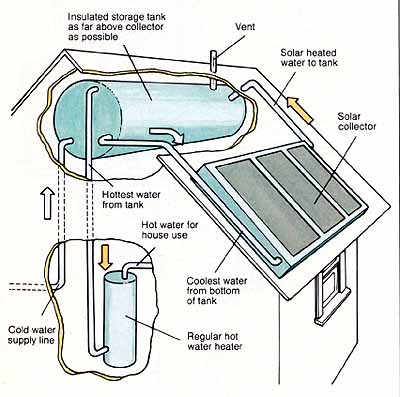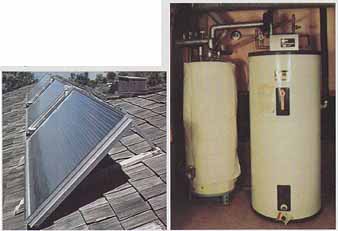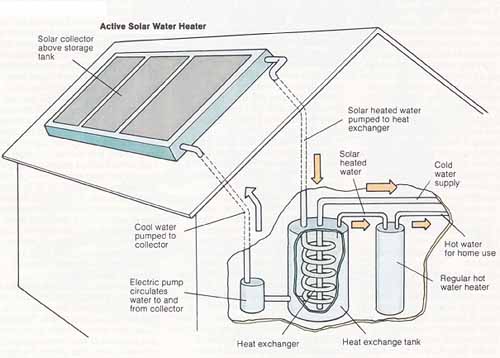Most solar hot water systems available on the market are not simply thermosiphon systems. They are, instead, active pump systems. As with active hydronic space heating systems, active solar water heaters use pumps to circulate water, and heat exchangers when anti freeze is used. They also are equipped with controllers that permit the pumps to work when the sun is capable of heating the water in the system.
The pumps most commonly used are to 1/36 – 1/12 horsepower, depending on the number of collectors used, pipe size, and the height difference between the storage area and the collection surface.
The controls used to activate the system measure the temperature difference between the coldest part of the water storage and the absorber collection area. The pump is turned on and off by signals from the controller. In order for the pump to be activated, the absorber plate needs to be about 7°F warmer than the storage at its coolest point, which is indicated by sensors that are attached to both the collector and the tank. When there is a temperature difference, it means that there is heat to be gained on the collector surface, and the pump is turned on to retrieve it. As long as the temperature difference remains, the pump will stay on and the fluid will be sent to the collectors to continue the warming cycle.
When the sun sets in the evening, the fluid in the collector becomes cooler than that in the tank. The sensor again activates a signal, to shut off the pumps. The pump will remain off until the next time the collector is warmer than the coolest point of the storage water.
• Auxiliary system: The auxiliary sys tem is connected to your existing hot water system in the following way: Water arrives in your home from a central supply at a cool temperature. It is ex posed to the sun through the collector and warmed. When hot water is required in the house, water is pulled from the hottest point of the storage tank into the domestic water heater. Since the heater’s thermostat has been preset for the desired delivery temperature, the heater automatically adjusts” the entering water to the temperature ready for delivery. For instance, if the water comes into your home at 60° F, and your desired temperature is 130°F, as soon as the solar system has heated the water to 100° F, about half your hot water heating has been accomplished by the solar energy system.
By setting the system up in this way, your home is supplied with hot water in virtually the same way as before, except that before the water reaches the standard water heater, the sun has pre heated it, so that less work is required of your existing system.
• Insulation: Good insulation on all pipes and tanks can't be stressed too much. If there is any possibility that freezing or near-freezing temperatures are going to be encountered, insulation is crucial. It takes only one cold night to burst pipes that may require whole-scale replacement to repair your system.
One effective way to prevent your water heater’s pipes from cracking in a freeze is to fill them with an anti freeze solution. Unfortunately, you can't drink antifreeze and live to enjoy your solar hot water.
• Heat exchangers: To get around this difficulty, heat exchangers are used. The most common forms of heat ex changers are copper or finned tubes immersed in the heated storage tank. A transfer fluid is pulled from the bottom of the coil, sent to the collector for heating, and returned through the top of the coil. As it travels down the tank, it “dumps” its heat into the domestic water supply.
There is also a “tube and shell” heat ex changer. This method uses two pumps: one to drive the heated fluid through one passage, and the other to send the water supply down the opposite passage in the other direction. Specific uses of heat exchangers may be regulated by your local building codes, which you should check carefully. But whatever you do, do not allow antifreeze into your house hold water.

Thermosiphon Solar Water Heater: Insulated storage tank as
far above collector as possible.
• Water supply: Although the optimum system for you will depend on your own particular circumstances, a useful rule of thumb in the United States is that a well-engineered system, installed and used properly, can supply a typical home with close to 100 percent of its summertime hot water requirements, about 25 to 30 percent of its winter requirements, and between 50 to 75 per cent of its annual hot water needs. Costs for a hot water system will run in the vicinity of $9500, installed. Savings vary depending on use and the cost of your present water heating system.

A solar water heater for domestic hot water consists primarily
of two elements: collectors and the storage tank. In this house, the owners
also installed a chill-chaser”, a small unit connected to the hot water
tank with pipes and mounted on the end of a kitchen cabinet. It provides
the added benefit of some space heat.
Closely kept records indicate how many therms of gas were saved after installation of system pictured at left. The more familiar the owners became with their system, the more they were able to save.

Active Solar Water Heater
Next: Solar Heated Swimming Pools
Prev: Domestic Hot Water; Bread Box Collector; Thermosiphoning Systems